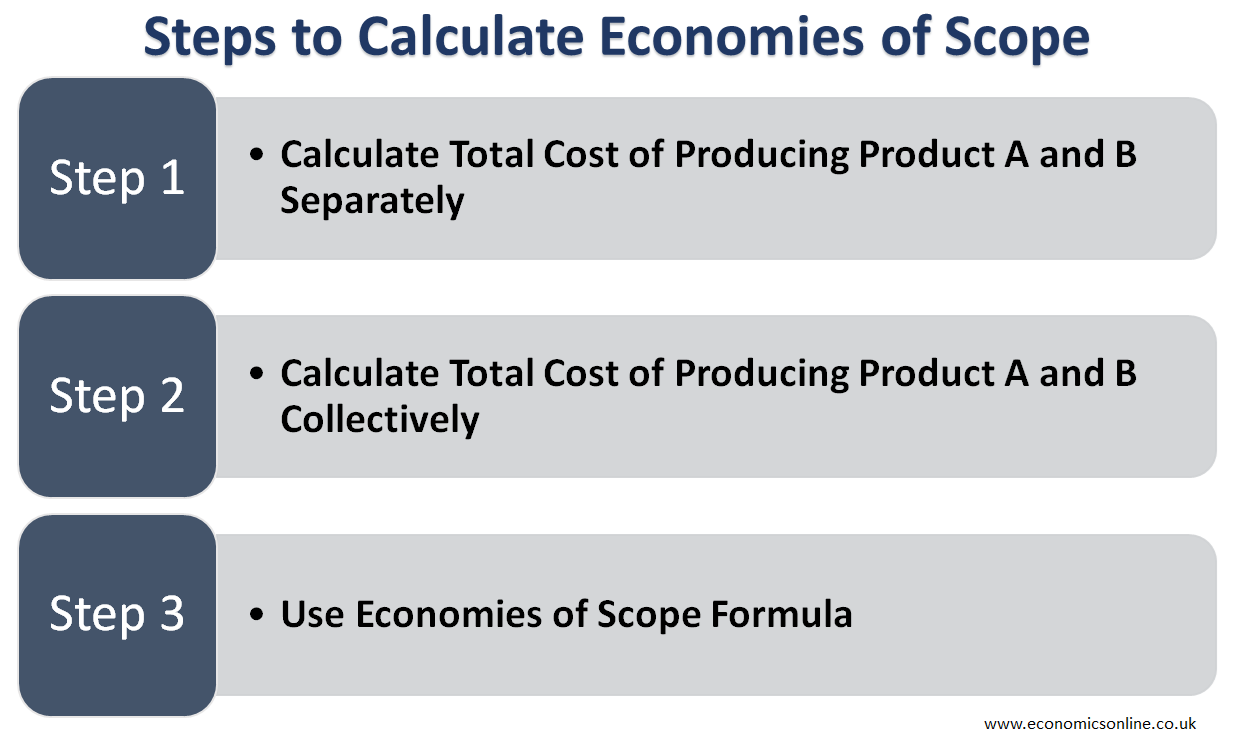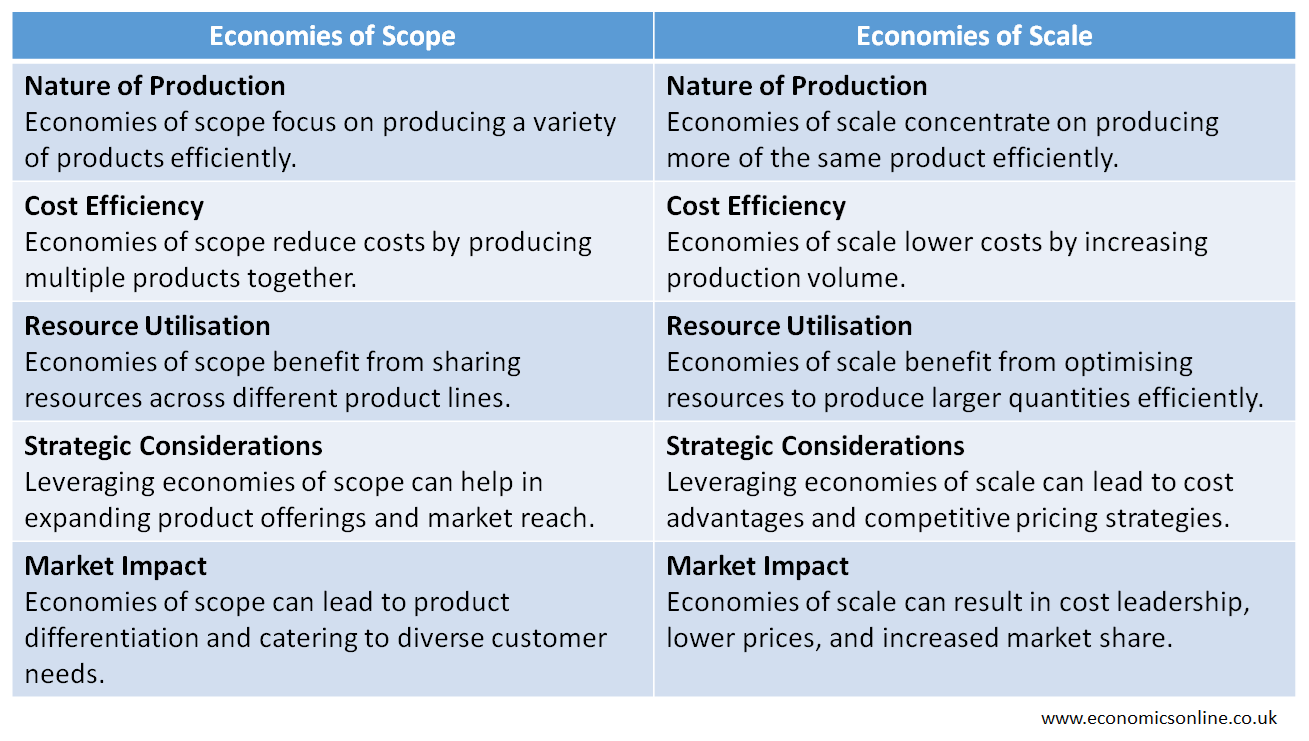
A photo of balloons of different colours.
Economies of Scope
Economies of Scope Definition
A concept in economics that refers to the decrease in cost of production when a range of multiple products are manufactured collectively rather than separately is called economies of scope. It means that the production cost of one product reduces the production cost of another product. It happens only when it is more cost-effective for firms to produce a variety of products collectively rather than producing less or producing each product independently. In some cases, the long-run average and marginal costs for firms decrease due to the production of complementary goods or services.
Although economies of scope can be distinguished by efficiencies due to the production of a variety of products, economies of scale can be distinguished by an increased production volume.
Economies of Scope Formula
The following formula can be used to measure the degree of economies of scope:

S = [C(QA) + C(QB) - C(QA + QB)] / C(QA + QB) x 100%
In this formula, S is percentage cost savings due to economies of scope, which is always greater than zero if the economies of scope exist in the given situation; otherwise, it will be different. C(QA) is the total cost of producing QA quantity of product A separately, C(QB) is the total cost of producing QB quantity of product B separately, and C(QA + QB) is the total cost of producing both quantities of products A and B collectively.
Steps to Compute Economies of Scope
Suppose that there are two products A and B, that a business firm Z can produce separately or collectively. For business Z, economies of scope can be calculated as follows:

The first step is to find C(QA), the total cost of producing QA quantity of product A separately, and C(QB), the total cost of producing QB quantity of product B separately. Each total cost can be calculated by multiplying the unit cost by the quantity produced.
The next step is to calculate C(QA + QB) which is the total cost of producing quantities of both products A and B collectively.
The final step is to get the percentage value of economies of scope by using the formula that we discussed earlier in this article.
Economies of Scope Example
Suppose that a fast-food business can produce burgers and sandwiches. The average cost of production of 500,000 sandwiches is $0.30 and the total cost is equal to $150,000 (500,000×$0.30=$150,000). The average total cost of production of 1,000,000 burgers is $0.50 and the total cost is $500,000 (1,000,000×$0.50=$500,000). If both products are produced together, then the total cost is $400,000. The following are the necessary calculations.
S = [C(QA) + C(QB) - C(QA + QB)] / C(QA + QB) x 100%
S = [($150,000 + $500,000 - $400,000) / $400,000] x 100% = 62.5%
The above answer is in percentage, and its interpretation is that the total cost of producing both products A and B together in the same facility, is 62.5% less than the total cost of producing them separately.
Further Explanation
The reason why firms have economies of scope is that it is cheaper and more economical to produce multiple products together than separately. For instance, it is cheaper to carry both passengers and freight in one train than using two trains: one for passengers and another for freight.
Economies of scope occur due to the fact that multiple products are produced in the same process. The sharing of resources among multiple products make their collective production cheaper. Additionally, fixed costs are distributed among multiple products, leading to a reduction in the average cost of production.
Co-Products
When there is a relationship between the co-production of final products, economies of scope occur. The goods produced in this process are called jointly produced goods. This happens when the production of one product automatically produces another product as a by-product or as a side-effect of the production process. Producing products together reduces the cost and waste of the production process and increases profit margins.
Complementary Production Process
When two or more products get into a direct interaction, economies of scope happen immediately. An example of this process is the companion planting process, in which three sister crops were cultivated by Native Americans. In this case, all three plants grow together, so the farmer produces multiple crops at the same time with relatively lower costs.
Shared Inputs
The shared inputs are the factors of production that are useful in producing more than one product. For example, a fast food restaurant can produce fries and chicken wings by using the same input resources. This will be cheaper as compared to producing them at two different facilities. This cost-efficiency is possible because the production of both products involves the same storage, fryers, and oil.
How to Achieve Economies of Scope
The following points explain how to achieve economies of scope:
Mergers
With the help of mergers, companies share their research and development costs or other resources to minimise the costs associated with producing or diversifying their product lines and information. For example, two pharmaceutical firms merge to share their R&D costs to produce new medicines in a cost-effective way.
Elastic Manufacturing
When different products are produced within the same manufacturing process and cost (factors of production), this will lead to elastic production or manufacturing. For example, in the process of making burgers and fries, the same production facilities and production process are used instead of using separate facilities for both processes.
Diversification
When companies have access to their operations expertise, resources, and strengths that they can use across their organisations, they may take advantage of diversification. For example, hiring experts in producing multiple products in different categories can lead to economies of scope.
How to Evaluate Economies of Scope
The following points explain how economies of scale are evaluated using multiple criteria:
Market Demand
It is important to understand market demand and the consumer’s interest in new product or service. Those products should be added in the portfolio which have demand in the market.
Brand Recognition
It is also necessary to consider how diversifying product range is related to or aligns with the brand recognition and reputation of the business.
Cost-Benefit Analysis
There is also a need to evaluate the cost of diversification against potential revenue and large benefits.
Supply Chain Consideration
It is important to understand and determine if your supply chain can support the production of new product or service.
Financial Implications
It is also necessary to analyse the investment needs and cash flow changes due to diversification.
Competitive Positioning
It is important to consider and understand how expanded scope positions the business firm in the competitive marketplace.
Sustainability
It is also important to understand the factors that affect long-term sustainability and the growth of business.
Economies of Scale
Economies of scale refer to the cost advantage companies achieve from increased total output of products or services. The long-run average total cost of production decreases with an increase in the scale of production.
Types of Economies of Scale
The economies of scale can be external or internal. It depends on whether changes originate from inside or outside the organisation. Some other types of economies of scale includes technical economies, which refer to changes in processes or technology; purchasing economies, which refer to the impact of bulk purchases of resources; and financial economies, which suggest that large companies can borrow at lower interest rates as being less risky.
Economies of Scope vs. Economies of Scale
The following table contains the main points of difference between economies of scope and economies of scale:

Importance of Economies of Scope
The following points explain the importance of economies of scope:
- It allows a business to attain efficiency by producing a variety of various products collectively.
- With the help of economies of scope, businesses are able to sell a product line with multiple products and respond according to the change in consumer buying behaviour.
- Economies of scope are important because they minimise the risk related to a company by allowing product diversification.
- When a company is totally focused on producing a single product, it is vulnerable to market changes. Economies of scope help a business in reducing this vulnerability.
Conclusion
In conclusion, economies of scope are a cost-effective way of producing multiple or complementary goods in the same production process instead of producing them separately. Economies of scope and economies of scale are related to each other. Economies of scope are important because they reduce risk and allow companies to diversify their product portfolio.


